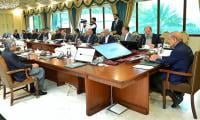ISLAMABAD: Within a few days, the PTI government is all set to be haunted by its own propaganda regarding the rise in Pakistan’s total debts and liabilities, which it has been interpreting as plunder of thousands of billions of rupees by the past “corrupt” rulers.
Informed sources in the Finance Ministry told The News that the debts and liabilities increased during the last six months, which include four-month tenure of the PTI, and are all-time high.
The precise figure of how much the government borrowed during the last six months, is expected to be announced in the next few days but a relevant Finance Ministry official, on condition of not being named, said that the overall debt added during this period was more than any time in the past.
The overall debts and liabilities in June 2018 were Rs29,892 billion, which rose to Rs30,875 billion by end Sept 2018. Gross public debt in June 2018 was Rs24,952 billion, which increased to Rs25,783 billion by end Sept 2018. The Oct-Dec 2018 figures are presently compiled with clear indications that it will make the borrowing in the first half of the current financial year all-time high.
Prime Minister Imran Khan and a number of his ministers and PTI leaders have been repeatedly referring to the rise in the country’s debt and liabilities to conclude that this money has been corrupted and gone into the pockets of past rulers, particularly belonging to the PML-N and PPP.
The PTI has been saying that the total of debts and liabilities, which was around Rs6,000 billion till the end of General Musharraf’s rule, had risen close to Rs30,000 billion during the last 10 years of the PPP and PML-N governments. Imran Khan, even after becoming the Prime Minister of Pakistan, had dubbed it corruption by the past rulers and had announced a forensic audit of this huge borrowing.
Although, the result of the forensic audit as was announced by the prime minister is still awaited, to the PTI government’s own embarrassment, its own borrowing during its four-month tenure is all-time high.
According to the Finance Ministry officials, the PTI will now realise that the narrative it had created on the issue of rising debt was ill-conceived. The source explained that borrowing for development is a good sign but in our case, the successive governments have started even borrowing money to meet their current spending and the present government is no exception.
However, to the government’s bad luck, its revenue shortfall is recorded at around Rs175 billion during the first six months, which means additional borrowing. Additionally, the PAC has been told that the circular debt, which stood at Rs1.14 trillion during the term of the previous government, has now increased to Rs1.4 trillion. It means that circular debt has increased by Rs260 billion during the last six months.
It shows that like the PPP and PML-N governments, the PTI government has also failed to check the high power losses. Circular debt is the consequence of high electricity losses that occurred due to theft and inefficiency in the distribution system besides poor recoveries against the total amount billed to consumers.
Despite the historic devaluation of Pak rupee against the US dollar by the present government to boost exports and bridge the trade deficit, the exports are also not picking up. Endorsing these precarious indicators of the country’s economy, even the PTI government’s spokesman Dr Farrukh Saleem had to admit that the government’s strategy, to correct the economy, has not worked as the efforts have been to treat the symptoms and not the disease. He said in a TV show that the government would have to consider some new strategy to improve the economy.
Saad was of the view that the battle of politics should be fought solely through political means
KP govt decided to develop gemstone business as a formal export sector and cluster at the Namak Mandi would be...
Khyber Pakhtunkhwa Minister for Higher Education, Archives, and Libraries, Meena Khan Afridi. — APP FilePESHAWAR:...
Vehicles and horse carts passing through flood water at Bara Bazar area on Khuwani bridge after heavy rain in Peshawar...
Amid the failure to revive the cash-bleeding PIA, government is left with no other option but to sell it to any...
Picture showing the Silver Jubilee Gate of the University of Karachi. — APP File KARACHI: The University of Karachi...







